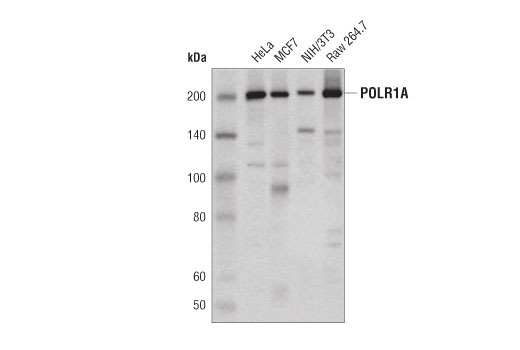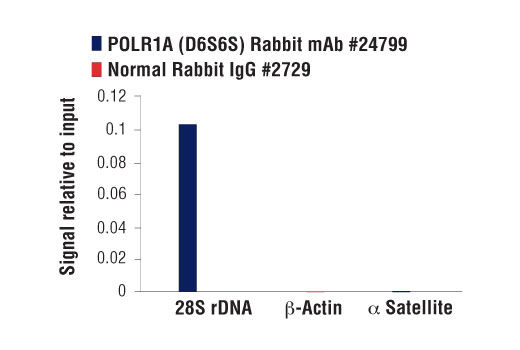WB, ChIP
H M Mk
Endogenous
200
Rabbit IgG
#O95602
25885
Product Information
Product Usage Information
For optimal ChIP results, use 10 μl of antibody and 10 μg of chromatin (approximately 4 x 106 cells) per IP. This antibody has been validated using SimpleChIP® Enzymatic Chromatin IP Kits.
| Application | Dilution |
|---|---|
| Western Blotting | 1:1000 |
| Chromatin IP | 1:50 |
Storage
Specificity / Sensitivity
Species Reactivity:
Human, Mouse, Monkey
Source / Purification
Monoclonal antibody is produced by immunizing animals with a synthetic peptide corresponding to residues surrounding Pro36 of human POLR1A protein.
Background
RNA polymerase I (RNAPI) is a large multi-protein complex that functions as a DNA dependent, RNA polymerase, which is primarily responsible for the transcription of ribosomal RNA (rRNA) genes. The largest subunit, Rpa194, or POLR1A, along with selectivity factor 1 (SL1), and the transactivator protein upstream binding factor (UBF) make up the core transcriptional machinery of the RNAPI complex (1-3). The RNAPI complex is recruited specifically to rDNA promoters by SL1, which contains TBP and TAF proteins, to transcribe precursors to rRNA (2). These precursors are processed into 18S, 5.8S, and 28S mature rRNAs, which make up most of the ribosomal structure (1). Similar to the RNA polymerase II complex, there are other core components that are required for transcription of target genes such as the TFIIH complex and SPT6 (4, 5). Overexpression of nascent rRNA has been shown to be associated with poor prognosis in certain cancer types, and enlarged nucleoli are a hallmark of cellular proliferation and aggressive tumors (6-8). Oncogenes such as Myc, Ras, and PI3K can drive RNAPI-mediated rRNA transcription, making POLR1A a key therapeutic target (9). Indeed, specific targeting of RNAPI activity with a small molecule inhibitor can induce autophagy selectively in tumor cells while having minimal effects in normal cells (10). Additionally, mutations in POLR1A are associated with acrofacial dysostosis, Cincinnati type, a cranioskeletal malformation syndrome. Loss of function mutations result in disrupted ribosome biogenesis and p53-mediated cell death affecting skeletal precursor cells or the neural-crest (11).
- Russell, J. and Zomerdijk, J.C. (2006) Biochem Soc Symp , 203-16.
- Jantzen, H.M. et al. (1990) Nature 344, 830-6.
- Comai, L. et al. (1992) Cell 68, 965-76.
- Iben, S. et al. (2002) Cell 109, 297-306.
- Engel, K.L. et al. (2015) Mol Cell Biol 35, 2321-31.
- Williamson, D. et al. (2006) Genes Chromosomes Cancer 45, 839-45.
- Derenzini, M. et al. (2000) J Pathol 191, 181-6.
- Maggi, L.B. and Weber, J.D. (2005) Cancer Invest 23, 599-608.
- Woods, S.J. et al. (2015) Biochim Biophys Acta 1849, 821-9.
- Drygin, D. et al. (2011) Cancer Res 71, 1418-30.
- Weaver, K.N. et al. (2015) Am J Hum Genet 96, 765-74.
Species Reactivity
Species reactivity is determined by testing in at least one approved application (e.g., western blot).
Western Blot Buffer
IMPORTANT: For western blots, incubate membrane with diluted primary antibody in 5% w/v BSA, 1X TBS, 0.1% Tween® 20 at 4°C with gentle shaking, overnight.
Applications Key
WB: Western Blotting ChIP: Chromatin IP
Cross-Reactivity Key
H: human M: mouse R: rat Hm: hamster Mk: monkey Vir: virus Mi: mink C: chicken Dm: D. melanogaster X: Xenopus Z: zebrafish B: bovine Dg: dog Pg: pig Sc: S. cerevisiae Ce: C. elegans Hr: horse GP: Guinea Pig Rab: rabbit All: all species expected
Trademarks and Patents
使用に関する制限
法的な権限を与えられたCSTの担当者が署名した書面によって別途明示的に合意された場合を除き、 CST、その関連会社または代理店が提供する製品には以下の条件が適用されます。お客様が定める条件でここに定められた条件に含まれるものを超えるもの、 または、ここに定められた条件と異なるものは、法的な権限を与えられたCSTの担当者が別途書面にて受諾した場合を除き、拒絶され、 いかなる効力も効果も有しません。
研究専用 (For Research Use Only) またはこれに類似する表示がされた製品は、 いかなる目的についても FDA または外国もしくは国内のその他の規制機関により承認、認可または許可を受けていません。 お客様は製品を診断もしくは治療目的で使用してはならず、また、製品に表示された内容に違反する方法で使用してはなりません。 CST が販売または使用許諾する製品は、エンドユーザーであるお客様に対し、使途を研究および開発のみに限定して提供されるものです。 診断、予防もしくは治療目的で製品を使用することまたは製品を再販売 (単独であるか他の製品等の一部であるかを問いません) もしくはその他の商業的利用の目的で購入することについては、CST から別途許諾を得る必要があります。 お客様は以下の事項を遵守しなければなりません。(a) CST の製品 (単独であるか他の資材と一緒であるかを問いません) を販売、使用許諾、貸与、寄付もしくはその他の態様で第三者に譲渡したり使用させたりしてはなりません。また、商用の製品を製造するために CST の製品を使用してはなりません。(b) 複製、改変、リバースエンジニアリング、逆コンパイル、 分解または他の方法により製品の構造または技術を解明しようとしてはなりません。また、 CST の製品またはサービスと競合する製品またはサービスを開発する目的で CST の製品を使用してはなりません。(c) CST の製品の商標、商号、ロゴ、特許または著作権に関する通知または表示を除去したり改変したりしてはなりません。(d) CST の製品をCST 製品販売条件(CST’s Product Terms of Sale) および該当する書面のみに従って使用しなければなりません。(e) CST の製品に関連してお客様が使用する第三者の製品またはサービスに関する使用許諾条件、 サービス提供条件またはこれに類する合意事項を遵守しなければなりません。

